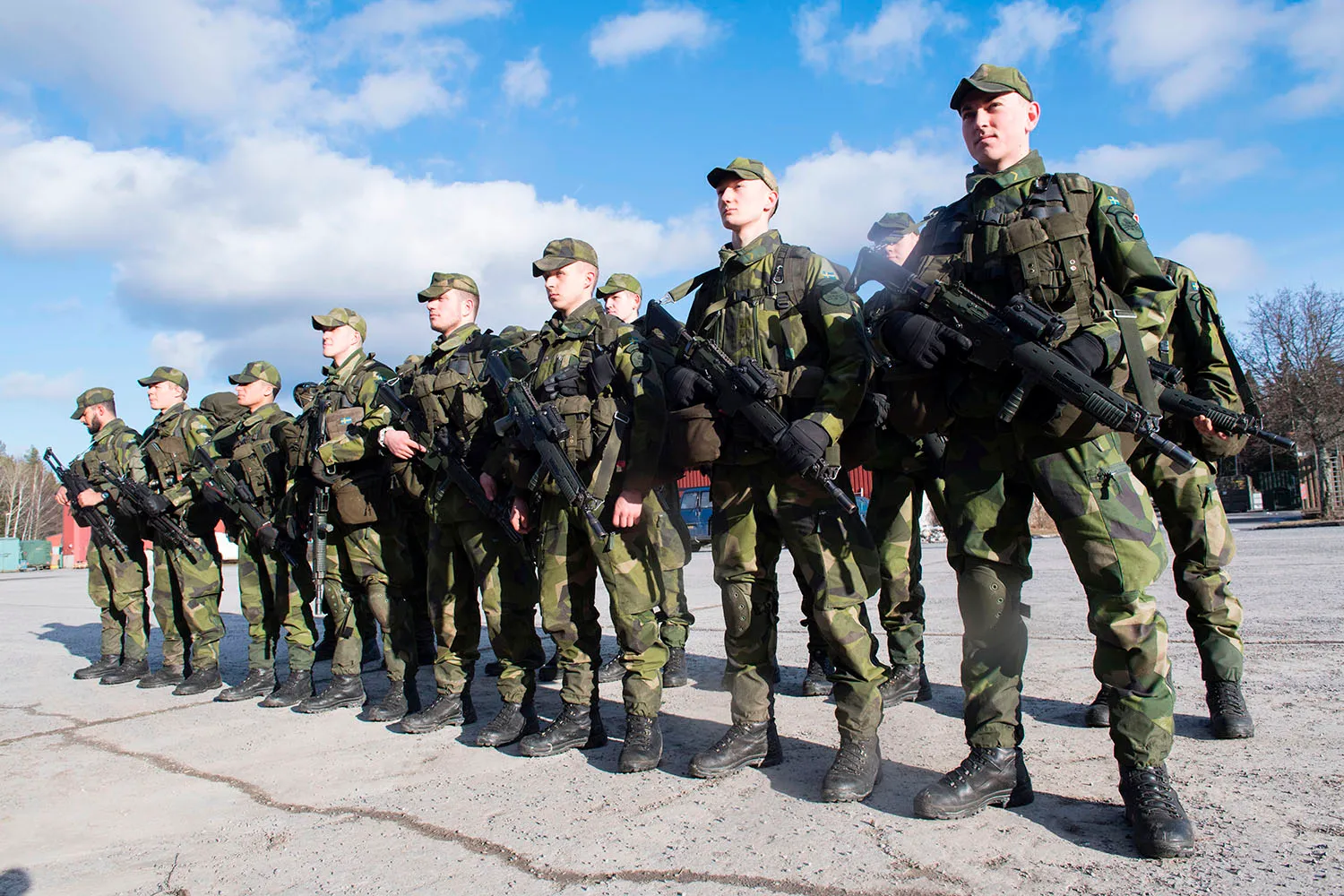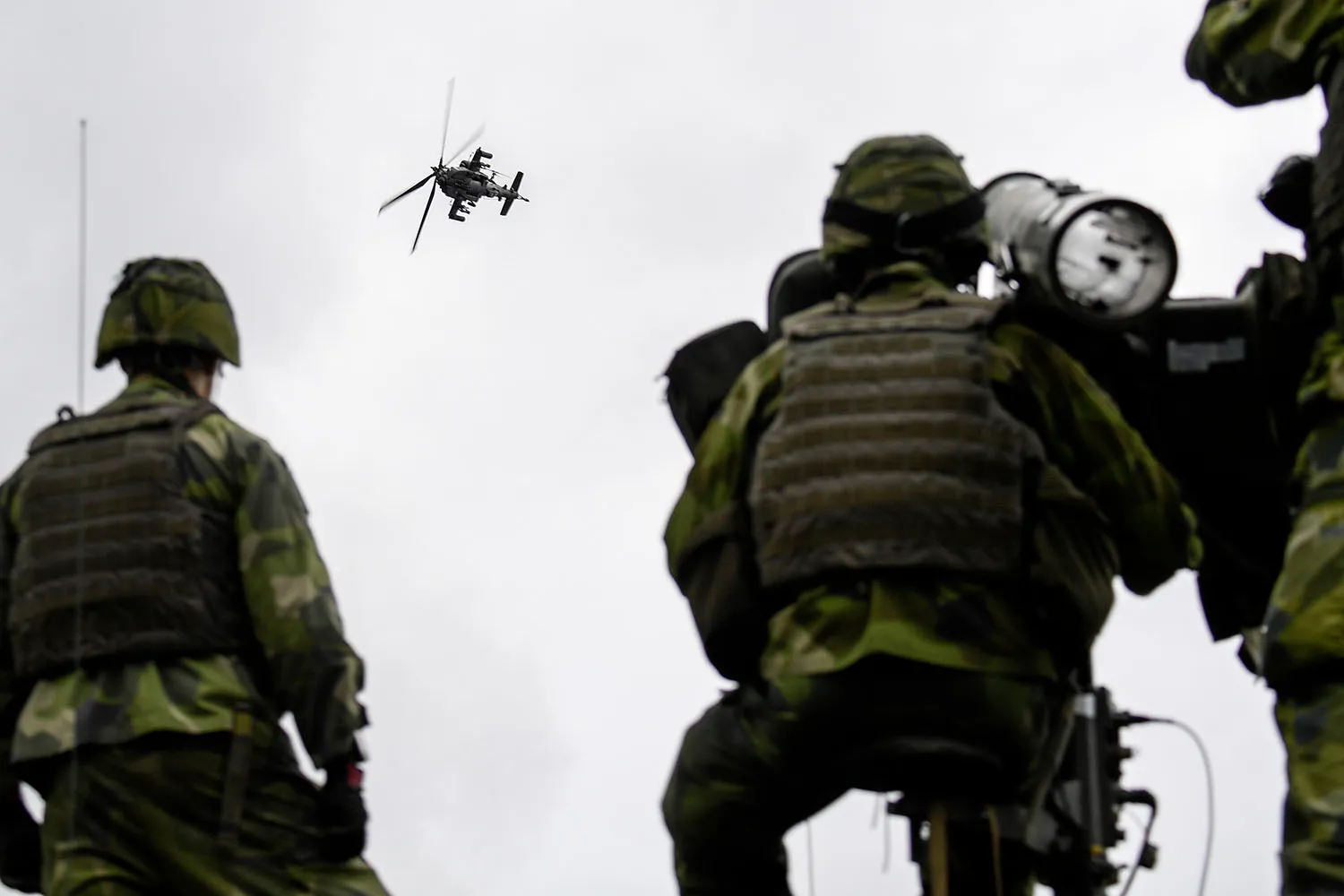The crew of a ship on the lookout to ensure Swedish neutrality during World War II in 1939. Keystone Archive/Getty Images
After the Cold War, Sweden took its peace dividend, too. Territorial defense, the Swedish Army’s raison d’etre while the Soviet Union was alive, became an afterthought. Swedish politicians and citizens increasingly viewed their military as a provider of peacekeepers and supporter of other expeditionary, multilateral operations—in essence, a luxury good for a state that didn’t need to worry about its own security. All conscription was suspended (though not legally abolished) in 2010, and the Swedish military shrank to fewer than 20,000 total soldiers.
The 2014 occupation of Crimea woke Sweden up—but so did basic math. In Sweden’s wealthy, highly individualistic society, voluntary military service held scant appeal. An experiment with part-time professional soldiers was a failure. The military shrank rapidly: By 2013, only 579 recruits completed the full 11 months of initial entry training. On Jan. 1, 2018, Sweden pulled the plug on its failed policy and restored mandatory military service.
Unlike the Cold War system, however, Swedish conscription is now both selective and gender neutral. A hundred thousand 18-year-olds are screened for service annually, but only about 5 percent of this cohort serves. Sweden aims to double this number by 2030. Roughly 10 percent of those serving do so unwillingly, with jail the alternative.

Young recruits are pictured during an inspection at the regiment in Enkoping, Sweden on March 2, 2017.
Young recruits are pictured during an inspection at the regiment in Enkoping, Sweden, on March 2, 2017. Fredrink Sandberg/AFP via Getty Images
Selective conscription, stiffened and led by a small professional force, potentially offers armies the best of both worlds. Since the military needs only a small fraction of every cohort, it can afford to be very picky—standards are higher in Sweden’s post-2018 force than they were before 2010. As in any society, this exclusivity functions as a signaling device: Educational and corporate leaders know that successful conscript service marks a young Swede as being in the top of his or her peer group—doubly so for the small portion of conscripts selected for additional training and longer service as junior officers.
As in any competent conscription system, Swedish national service has two major advantages beyond the basic manning of the military: talent acquisition and expansion of reserves. On the front end, Sweden can screen all young people in the nation, select the most promising for military service, and then attempt to induce the best to stay on for a military career. On the back end, each cohort of conscripts, most of whom will complete their service in nine months, becomes another brigade’s worth of soldiers in the military reserves. Though reservists require regular call-ups to maintain readiness and proficiency, even a poorly managed reserve has military utility in a crisis. The Russian Armed Forces proved this 18 months ago, when it mobilized 300,000 men who had not trained or fought since their initial military service years before. Russia’s partial mobilization was hasty and bloody, but it was still critical to stabilizing Russia’s lines during Ukraine’s Kharkiv counteroffensive.
Sweden was fortunate in that it was restoring a conscription system that had been dormant for less than a decade. When the system was restored, all serving field grade officers and generals had served as conscripts themselves. But the restored selective conscription system included major changes: Women were fully integrated (they now make up about 15 percent of conscripts), and Sweden established a long-service professional noncommissioned officer corps, something that had been absent in the Cold War mass army.
The success of Sweden’s selective conscription system has created a virtuous cycle. In an inversion of the paradigm afflicting most NATO countries, service begets service. Sweden’s Home Guard, a voluntary reserve for territorial defense, has seen recruitment quadruple in early 2024 compared to the same time a year earlier. Once an aging and socially irrelevant force, the Home Guard is suddenly popular with young Swedes, who have seen restored conscription and Sweden’s new seriousness about national defense as evidence that military service is an honorable and necessary component of citizenship.
Other volunteer auxiliary defense organizations, like the all-women Lotta Corps, have gained proportionately even more new members than the Home Guard. In January, Sweden also restored compulsory civic service, committing municipal rescue workers and critical infrastructure personnel to enhance the country’s official national strategy of societal “total defense.” As Swedish Prime Minister Ulf Kristersson bluntly told his country: “Citizenship is not [just] a travel document.”

Swedish soldiers during a military exercise on the island of Gotland, Sweden on Sept. 19, 2017.
Swedish soldiers during a military exercise on the island of Gotland, Sweden, on Sept. 19, 2017. Anders Wiklund/AFP via Getty Images
In the face of renewed Russian aggression, what NATO needs most urgently is mass, in both active and reserve forces. Some analysts have called for rejuvenating Europe’s reserves within the context of all-professional militaries. But this fails to solve the recruiting problem. In fact, many countries have reserve recruiting problems that are even more severe than those for the active force. Why volunteer to put up with the disruption, dislocation, and danger of military life for only limited pay and benefits?
There is also the cost issue. European efforts at rearmament are caught between a rock and a hard place—between static budgets and the enormous costs of being ready for modern war. For Europeans forgetful of their continent’s less-than-peaceful history, the scale is mindboggling: Russia has lost the equivalent of 15 Bundeswehrs’ worth of equipment in Ukraine and is still fighting. Purchasing sufficient weapons and munitions will devour European military budgets before any meaningful increase in manpower can be considered. Germany’s vaunted Zeitenwende, to take one example, is off to an excruciatingly slow start.
Most Western countries will struggle to afford meaningful military mass without the enormous budgetary advantage that conscription confers. Expanding personnel in a professional military comes with a huge price tag in compensation, benefits, and recruiting outlays, and many European militaries struggle to attract sufficient recruits due to comparatively poor pay. And as many NATO members struggle to reach the alliance’s defense spending floor of 2 percent of GDP, conscription offers both cheap capacity and a way to demonstrate commitment that goes beyond budgets. Swedish conscripts earn the equivalent of about $450 a month—a fifth of what a U.S. Army private first class is paid.
European leaders are beginning to grasp that their professional military model is failing. German Defense Minister Boris Pistorius has publicly described the end of German conscription in 2011 as a “mistake.” The head of the British Army, Gen. Patrick Sanders, has described young Britons as a “prewar generation” who may be called to national service. Both men have pointed to Sweden as a potential model.
For NATO’s 29 other European members, Sweden’s selective conscription example is potentially transformative. Finland, Sweden’s neighbor and alliance predecessor, draws even more attention for its system of universal male service, but Sweden’s system offers a more useful model for countries struggling with military manpower and national commitment but unwilling to take the drastic step toward universal mandatory service. In its renewed Home Guard and civilian defense organizations, Sweden also shows the downstream benefits of restoring an ethos and expectation of citizen service.
Even if Russia is ultimately stopped in Ukraine and its threat to Europe reduced for now, a less stable future with potentially less support from the United States is going to demand more robust and resilient territorial defense from European states. Once they’re done celebrating NATO’s newest member, the alliance’s leaders should take a close look at what they can learn from Sweden’s restored system of national service.
Source link : https://foreignpolicy.com/2024/03/15/sweden-nato-military-conscription-model-defense/
Author :
Publish date : 2024-03-15 07:00:00
Copyright for syndicated content belongs to the linked Source.


